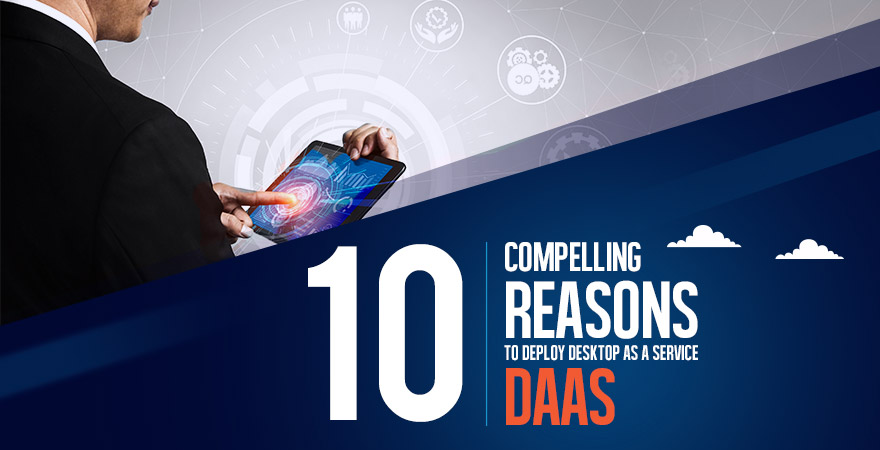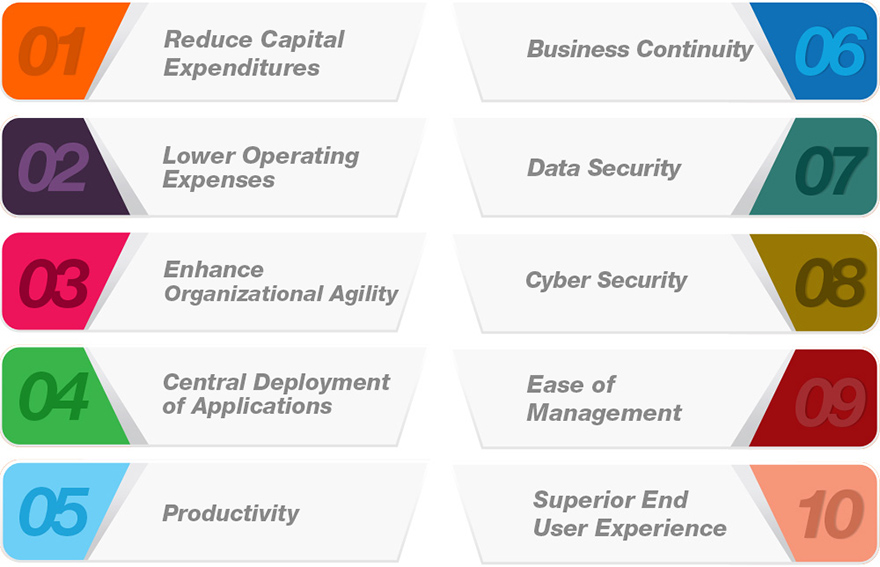The modern workplace is evolving at a very rapid pace. Long gone are the days when employee productivity was limited to just the workplace. Similarly, employees now want productivity tools to be at their disposal round the clock.

Another trend that has rapidly picked up pace over the past few years has been remote work. The concept around remote work is that employees no longer need to physically show up at the workplace in a lot of work scenarios.
Now, to deliver productivity and a seamless user experience right to the end user level that is independent of time and space is a challenge in itself. However, if this feat can be accomplished, it can have very positive results on productivity and employee motivation.
Also Read:
- DaaS by dinCloud – A Life Changing Technology for Your Business
- How Desktop as a Service (DaaS) Enables Collaborative Learning?
Challenges of Conventional IT Infrastructure
The conventional IT setup that revolves around the workplace itself has its own set of challenges and administrative overheads. Let’s cover a few:-
CapEx
To maintain a sizeable IT hardware on premise, you need to shed loads of cash up front. You need to provide each employee with a dedicated desktop or laptop PC.
IT Support
With a large IT infrastructure housed within the organization, you need a strong team of IT personnel that ensures all the hardware is working fine and for its troubleshooting.
Integration Issues
As your organization grows, you keep adding IT hardware on a piece meal basis from various manufacturers and vendors. This creates major integration challenges.
Data Security
In the conventional IT setup, your organizational data is scattered over hundreds or thousands of end point devices that poses serious risks related to its security.
Productivity
If your employees don’t have access to the workplace for some odd reason, productivity would either suffer or be non existent unless the situation subsides.
Admin Expenses
Having a large IT hardware footprint spells further bad news for your operating expenses, which will keep swelling on account of upgrading and maintaining hardware resources.
Also Read:
- Virtues of VDI and DaaS in Achieving Organizational Efficiency
- How VDI and DaaS are Supporting Remote Work?
Virtual Desktop Infrastructure – The Initial Solution
Once organizations could no longer cope with burgeoning IT hardware and related expenses, they became desperate for a virtualization solution. The initial solution to this problem came in the form of Virtual Desktop Infrastructure or VDI.
In a VDI deployment model, instead of giving a physical PC to each employee, you create virtual instances of desktop computers in house over a data center and serve them from the company’s internal network in most cases.
If you wanted to extend the scope of VDI beyond company premises, you could do that by adding an additional layer of security through a Virtual Private Network or VPN. Users would log on to their Virtual Desktops and execute workloads.
Challenges of VDI
Despite its obvious benefits over a conventional IT infrastructure, VDI still had its own fair share of problems. The foremost issue was with the very high initial cost of setting up a data center on premise that would house and support all the Virtual Desktops.
Secondly, to setup and effectively manage a VDI solution, each organization required highly skilled IT professionals that would manage the whole infrastructure. It would be unfair to say that VDI was not an effective solution at all.
Despite the above drawbacks, VDI still streamlined organizational workflows by enhancing their agility and the ability to on board new employees in a much shorter timeframe. Still, setting up a VDI infrastructure was mostly beyond the reach of small to medium businesses.
DaaS – An Effective Alternate to VDI
The answer to most of the challenges specific to VDI came in the form of Desktop as a Service or DaaS. The DaaS model also delivers Virtual Desktops to your doorstep, but from the infrastructure of a third party Cloud Service Provider (CSP) like dinCloud.
In the DaaS model of deploying Virtual Desktops, you don’t need to setup an in house data center or maintain it. Instead, all the functions related to procuring, maintaining, integrating and optimizing the hardware resources is performed by your CSP.
In case of DaaS, all your Virtual Desktops exist in the vast data centers of your CSP, which your employees can access from a wide range of login devices such as smartphone, tablet, desktop or laptop. All you need is a web browser and an internet connection.
Once you login to your Virtual Desktop, all the data and productivity apps are served by your CSP’s infrastructure. You have round the clock access to your VDs, which gives you the freedom to work as and when you feel most productive.
Also Read:
- Leveraging the Cloud to Cope With the Effects of Covid-19
- The Challenges of VDI in Post Covid-19 Scenario
In exchange for using the CSP’s infrastructure, you will pay a fee that is generally agreed before you engage in any such arrangement. Now that we have listed the core characteristics of DaaS, let’s highlight some of its key benefits:-

Reduce Capital Expenditures (CapEx)
Organizations are under increasing pressure to curtail IT related spending, without compromising on employee productivity. With DaaS, you don’t have to commit to Capital Expenditures in setting up a data center on premise.
Lower Operating Expenses
As DaaS uses the hardware resources of your CSP, you no longer need to invest in high spec end point devices. You can make do with relatively obsolete IT hardware for a much prolonged period as your end point devices are just used for inputs.
Enhance Organizational Agility
DaaS solutions are highly agile, which in turn improves the agility of your organization. You can easily deploy and decommission Virtual Desktops at will, without ever worrying about the underlying hardware resources, which are managed by your CSP.
Central Deployment of Applications
Over the DaaS solution, you no longer need to install, update or patch productivity applications on each end point device. All this needs to be done once at the data center level and the impact is universally passed on to all your Virtual Desktops deployed.
Productivity
In case of DaaS, the productivity of your workforce is independent of time and space. Your employees can login to their Virtual Desktops from the workplace, home or even while they are travelling. DaaS is otherwise highly suited for remote work scenarios.
Business Continuity
DaaS solutions are nearly immune from disruptive events such as earthquakes, floods, strikes and pandemics etc. Your workforce can remain fully productive even if they cannot physically turn up at the workplace.
Data Security
In a DaaS solution, all your organizational data is consolidated in the data center of your CSP instead of countless end point devices. This makes securing data much more manageable. You also don’t risk losing data in case of loss or theft of an end point device.
Cyber Security
Most organizations lack the in house capability to effectively secure organizational data. CSPs on the other hand adopt a multi dimensional approach to cyber security that includes firewalls, intrusion detection, malware protection, encryption and more.
Also Read:
- Cyber Security as a Catalyst for Organizational Growth In 2020
- Top 11 Guidelines for Cloud Security in 2020
Ease of Management
A DaaS solution is very easy to manage at the organizational level as most of the core functions are taken care of by your Cloud Service Provider (CSP). This frees up both time and resources so that you can focus more on core business operations.
Superior End User Experience
When you deploy a DaaS solution, you not only enhance productivity but also deliver a much more consistent, superior and seamless end user experience to all your employees. This in turn improves employee retention rates and motivation levels.
Conclusion
Realizing all the above benefits of DaaS hinge on choosing the most appropriate Cloud Service Provider (CSP) that has both the capacity and the capability to serve your existing as well as future virtualization needs.
dinCloud is a premier Cloud Service Provider (CSP) that offers a wide array of fully virtualized cloud solutions at the individual and enterprise level. Our solutions include Cloud Hosted Virtual Desktops (dinHVD), Servers and Database Solutions.
dinHVD is our flagship product which is a fully Virtualized Cloud Hosted Virtual Desktop. It comes equipped with a seamless Windows 10 experience, coupled with some of the latest and fully licensed productivity applications for your organizational needs.
We have a unified portal called dinManage that empowers you to manage all the key facets of your DaaS solution in a matter of just a few clicks. dinManage allows you to manage, scale, configure and regulate your DaaS solution the way you like it.
At dinCloud, we have a sound track record in cyber security because we employ some of the industry leading protocols for physical and cyber safety of our data centers, which in turn keeps your valuable data at bay from threats and vulnerabilities.
Why Choose dinHVD by dinCloud?
Our DaaS solution (dinHVD) comes with some of the most competitive, flat rate pricing model that does not entail any migration or other hidden costs. This implies that once you transition to our DaaS solution, your cloud bill will be predictable right down to each dollar.
Contact Us to convey your DaaS or any other cloud powered needs and we at dinCloud will chalk out a virtualization solution that is not only the best in terms of performance, but also pricing. Your transition to the cloud will be a breeze with dinCloud.


